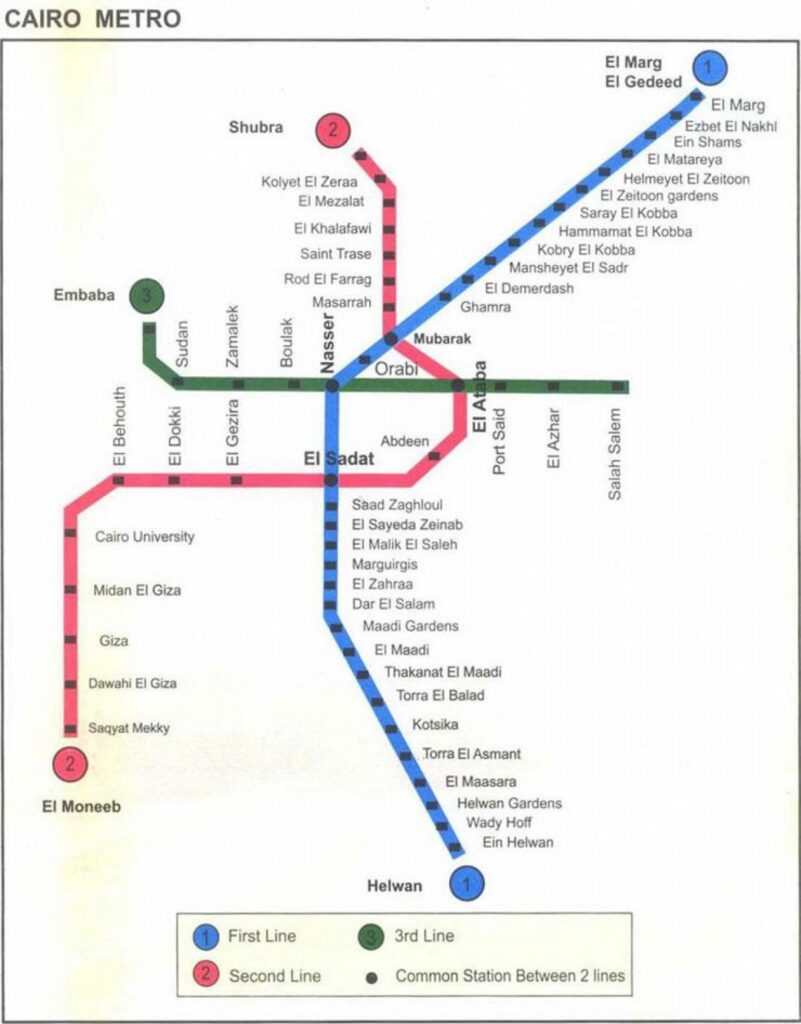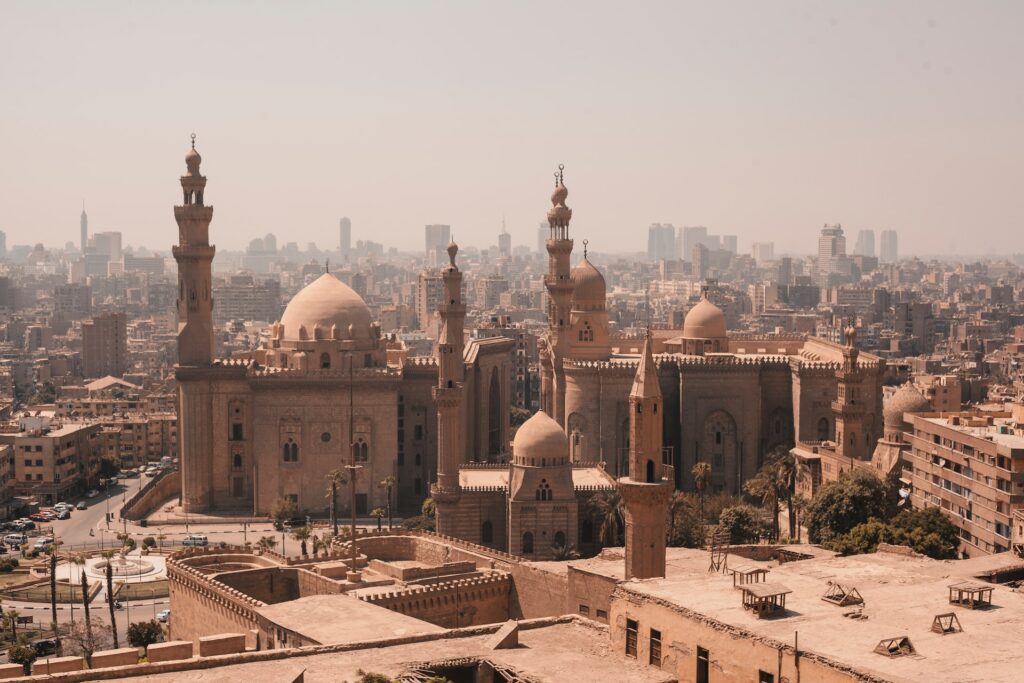There are a lot of buses, minibusses, taxis, and metro systems for the public to use in Cairo. Since it is the quickest and most effective means to move throughout the city, the Cairo Metro is the most widely used mode of public transit. Over 1.5 million people use the three lines of the metro every day. Taxis can be hailed from the street or a taxi stop and are also readily accessible. Buses are the most affordable mode of public transportation, although they can be slow and crowded. Similar to buses, but more adaptable and able to deliver door-to-door service, are minibusses. In Cairo, all of the public transportation options are cheap and make it easy to get around the city.
Basic information about the Metro system in CAIRO
Cairo’s metro system is an essential component of the city’s public transit network. With the first line opening in 1987, it is the oldest metro system in Africa and the Middle East. Two lines, the North-South Line and the East-West Line, with a combined length of 75 kilometers and 50 stations, make up the metro system. The metro runs from 5:00 a.m. to midnight, with trains running every 3–10 minutes. Many of Cairo’s top sites are easily accessible via the metro, which is a practical, reasonably priced, and dependable way to move around the city. Any traveler should go there because it is a fantastic way to see the city.
The lines of the Cairo subway system
The Cairo Metro is one of the biggest and most well-liked public transit systems in the entire world. It is located in Cairo, Egypt. The Cairo Metro, which includes three lines and over 50 stations, has been in use since 1987. For the more than 20 million residents of the greater Cairo metropolitan area, it is a crucial mode of transit.
The busiest line in the system is Line 1 of the Cairo Metro, which runs from Helwan to El-Marg Station. It has a length of 28.5 kilometers and carries more than 800,000 people daily. 22 stations make up Line 1, which runs the length of the city from south to north.
The newest addition to the Cairo Metro is Line 2, which debuted in 2012. It is 16.5 kilometers long and extends from Shubra El-Kheima to Giza. Eight stations make up Line 2, which links Cairo to Shubra El-Kheima and Giza, two nearby cities.
The longest of the three lines in the Cairo Metro is Line 3, which is the third line. It connects Giza to Cairo International Airport and is 51 kilometers long. With 22 stations and more than 1.2 million daily riders, Line 3 is the busiest line in the system.
Millions of people use the Cairo Metro every day, which is an essential component of Cairo’s public transit network. It is one of the best ways to get around the city, and it is always being improved and updated. The Cairo Metro is a practical and affordable method to see the city, whether of whether you live there or are simply visiting.
Map of Cairo Metro 2023 – Free Download in PDF

In Cairo, Egypt, the Cairo Metro is a frequently used public transit system. This map of the Cairo Metro in 2023 shows a complete picture of the whole system. It displays all existing and future stations along with the lines to which they are connected. The map is a useful tool for people who commute and travel, and it can be downloaded for free in PDF format. It is excellent for navigating Cairo’s streets and for making travel arrangements. Travelers may simply navigate the city and make the most of their time in Cairo with the aid of this map.
Public transport tickets in Cairo- Best types for travelers & actual prices
Cairo is a busy and energetic city, and many locals place great importance on being able to move about easily and safely. The most well-liked mode of transportation in the city is public transportation, and there are numerous ticket options to meet everyone’s demands.
The Metro is the most well-liked mode of public transportation in Cairo. Tickets are available from the ticket office at each station for the two lines of the Cairo Metro, Line 1 and Line 2. Before boarding the train, tickets must be bought; the cost varies based on the location. For instance, a ticket from Al Ahram to Giza costs 7 LE for one-way travel and 14 LE for round-trip travel.
The bus is another well-liked mode of public transportation in Cairo. Cairo has a wide range of bus options, including city buses, express buses, and minibusses. Both the driver and the ticket window are available for purchase at each bus stop. A one-way ticket normally costs between 2 and 5 LE, though prices vary based on the bus type and the location.
The cab, which is typically the most expensive mode of public transportation, provides an additional option for moving around Cairo. The cost of a taxi varies based on the destination and can be hailed from the street or reserved in advance. From downtown Cairo to Giza, a typical one-way trip runs about 25 LE.
The tram, which travels around the city and is a fantastic means of transportation, is the last option. Each station includes a ticket office where you can buy tickets, and the cost varies based on where you’re going. From downtown Cairo to Giza, a typical one-way ticket costs about 5 LE.
Cairo’s public transportation system is a fantastic method to move quickly and safely throughout the city. Before purchasing your ticket, make sure to compare costs and destinations as there are many different tickets available. You can locate the ideal ticket for your needs with a little bit of study!
Summary of fares for public transport in Cairo
- Bus is another popular form of public transportation, tickets can be bought from the driver or ticket window and cost between 2-5 LE
- Taxi is the most expensive form of public transportation, cost varies depending on the destination, and can be hailed from the street or reserved in advance
- Tram is another option, tickets are bought from the ticket office and cost about 5 LE from Cairo to Giza
Timetables & Schedules of Cairo Metro system
Every day from 5 a.m. to 1 a.m., the Cairo Metro system runs at a frequency of every 5 minutes during peak hours and every 10-15 minutes during off-peak hours. The first and last trains of the day are always the same, and the same schedule is followed on weekends as well. Additionally, there are peak-hour express trains in the Cairo Metro system that run more often than normal trains. During rush hours, the Cairo Metro system also offers a unique service to a small number of places. This service runs from 4:30 a.m. to 12:30 a.m. with a frequency of every two minutes during peak hours and every five minutes during off-peak hours.
What Are Other Options For Public Transportation In Cairo?
Cairo is the biggest city in both Egypt and the Middle East, and its residents highly value its public transit system. The Cairo Metro is without a doubt the most well-known and frequently utilized mode of public transit, but it is not the only one. There are many more kinds of public transportation in Cairo, and many of them have their own uses.
Cairo buses
Cairo has buses, to start. A large portion of the city is served by the city’s bus network. The buses are dependable and reasonably priced, however, passengers could find them crowded during rush hour. Minibusses are another option. They are more common, smaller, and can take you to many places in the city quickly and easily.
The most convenient way of travel is by Taxi
Another well-liked form of public transit in Cairo is the taxi. Taxis are easy to find and can be booked ahead of time or flagged down on the street. Even though they usually cost more than buses, they are faster and easier to use, especially during rush hour.
Something special? Tuk-tuks or ferries
There are also tuk-tuks, which are three- and four-wheeled motor vehicles, for those seeking a more distinctive experience. These can frequently be seen in locations not served by taxis or buses because they are smaller and less expensive than taxis. Finally, there are ferries that run down the Nile River, offering a different and frequently beautiful mode of transportation within the city.
In short, in addition to the well-known Cairo Metro, there are other modes of public transit available in Cairo. When trying to get around the city, you need to think about all of your options because each of them is good for different things.
How To Get From Cairo International Airport (CAI) To The City Center With Public Transport?
It can be overwhelming to make the trip from Cairo International Airport to the city core. Fortunately, there are several different public transit choices available to make travel simpler. Public transportation from Cairo International Airport to the city center is simple and reasonably priced, with options like buses and taxis.
From Cairo International Airport, the Metro is one of the most well-liked modes of public transit. From the airport to the city center, this train service runs continuously. The Metro is the most economical choice because a single ticket only costs a few Egyptian pounds. From Giza Station to the Airport Station, the journey takes roughly 30 minutes.
From Cairo International Airport to the city centre, there are a few bus routes you can choose from. The most well-liked alternative for getting from the airport to the centre of Cairo is the Airport Express Bus. It takes about 45 minutes and costs about 10 Egyptian pounds to catch this bus.
Travelers can choose a taxi for a more relaxing trip. In the arrivals section of the airport, taxis are easily accessible. Usually, it takes 30 minutes to get to the city centre, and the fee is about 100 Egyptian pounds. Prior to beginning the trip, be sure to agree on the fare.
Using public transit to go from Cairo International Airport to the city centre is simple and reasonably priced, regardless of the route you pick. Travelers can locate the ideal alternative to meet their needs with a little forward thought and investigation.
What kind of sightseeing DO you have to see if you visit Cairo for THE first time?
Egypt’s capital city, Cairo, is a fascinating place with both historical and contemporary landmarks. There is something for everyone to explore in Egypt, with its recognizable pyramids and lively bazaars. The top Cairo tourist destinations are listed below.
First, a visit to the Great Pyramids of Giza is a must-do activity on every vacation to Cairo. These historic buildings, which were allegedly constructed more than 4,500 years ago, are the last of the Seven Wonders of the World still standing. Visitors can tour the area and discover more about the fascinating history of these magnificent monuments. There are three main pyramids, each with its own distinctive features.
The Egyptian Museum is yet another must-visit destination in Cairo. The museum, which is situated in the centre of the city, is home to more than 120,000 objects, including the well-known mummies of ancient pharaohs and the well-known King Tutankhamun treasures. The galleries are open for visitors to explore, where they may find out more about the historic cultures that once controlled Egypt.
Another well-liked site is the Cairo Citadel. This 12th-century fortification in the middle ages has walls and a moat around it. It’s an excellent destination to explore because it has many mosques and museums inside.
Visitors can ride down the Nile in a felucca, a traditional wooden boat, for a unique experience. These boats are a wonderful opportunity to appreciate the grandeur of the river and a tranquil way to take in the views, sounds, and smells of the city.
Last but not least, a journey to Cairo wouldn’t be complete without stopping by the city’s famous bazaar, Khan el-Khalili. Visitors can find a wide range of stores, kiosks, and cafes here, selling everything from spices to jewelry and authentic mementos of Egypt.
Cairo is a fascinating city with both historic landmarks and contemporary attractions. Everything from the Great Pyramids of Giza to the crowded bazaars of Khan el-Khalili can be experienced. Cairo has a variety of attractions that are sure to leave visitors with lifelong memories.
Summary of our tour guide for Cairo
Cairo is the capital of Egypt and the largest city in Africa. It is a bustling and vibrant city, known for its riEgypt’s capital, Cairo, is also Africa’s largest city. It is a lively, energetic city renowned for its extensive history, delectable cuisine, and rich culture. Cairo, the most populated city in the Middle East, welcomes countless tourists from around the globe every year. Cairo has a sizable population, but it also has an effective public transportation infrastructure that allows residents to get around the city via the metro, buses, and taxis. Cairo’s public transportation system provides a dependable and cost-effective method to travel, whether you’re hoping to learn more about the history and culture of the city or are just trying to find a handy way to get around.
Top 5 FAQs and answers about Cairo public transport?
- Does Cairo have good public transport?
- Cairo has a big network of public transportation with a number of buses, micro-buses and a large network of roads in addition to the ring road which encircles the important parts of Cairo. Ramsis Square and Abd El Moneim Riyad Square are two of the best places to find transportation to almost anywhere in the city.
- What is the transport problem in Cairo?
- In relation to its large and growing population, Cairo has a very small metro system. It is far smaller than the systems of other major cities, but much more crowded. Despite being half the size of the Washington, DC metro, it transports four times the number of passengers per km of line.
- What is the main transport in Cairo?
- Cairo’s Metro system is by far the most efficient way to get around. There are three lines that converge in the center of the city, and trains carry passengers to attractions like the Egyptian Museum and those found in Coptic Cairo.
- How many people use public transportation in Egypt?
- Ninety percent of Egyptians regularly use public transport, with the remaining 10 percent using private cars and motorcycles, says Atef Suleiman, professor of road engineering at Ain Shams University.
- How fast is Cairo metro?
- This line carries trains with 3 units (9 train cars), which have a headway of 3:30 to 4 minutes, and a maximum speed of 80 km/h (50 mph). The line can carry 60,000 passengers per hour in each direction.
Useful links







